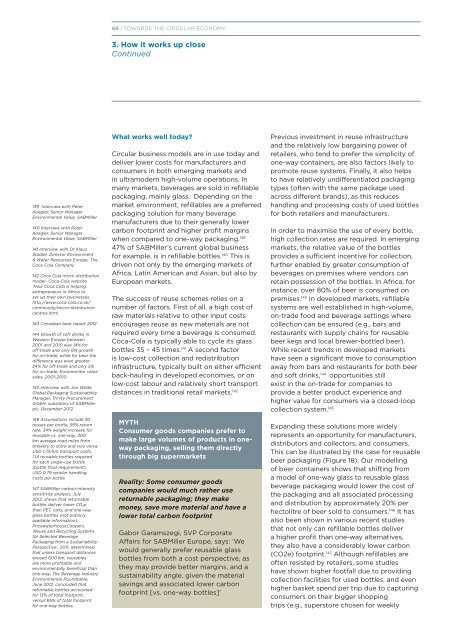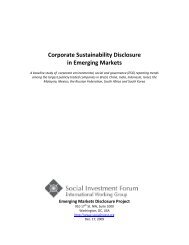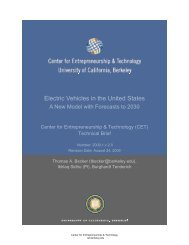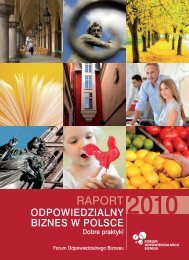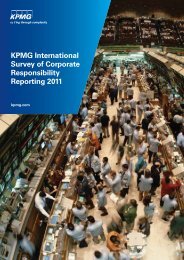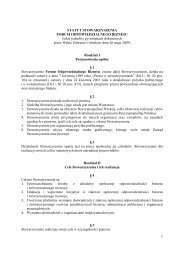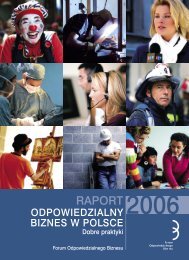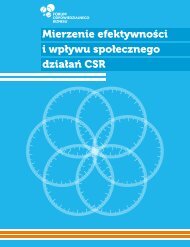The Circular Economy - 2013 Report - State of Texas Alliance for ...
The Circular Economy - 2013 Report - State of Texas Alliance for ...
The Circular Economy - 2013 Report - State of Texas Alliance for ...
You also want an ePaper? Increase the reach of your titles
YUMPU automatically turns print PDFs into web optimized ePapers that Google loves.
68 | TOWARDS THE CIRCULAR ECONOMY<br />
3. How it works up close<br />
Continued<br />
139 Interview with Peter<br />
Koegler, Senior Manager<br />
Environmental Value, SABMiller<br />
140 Interview with Peter<br />
Koegler, Senior Manager<br />
Environmental Value, SABMiller<br />
141 Interview with Dr Klaus<br />
Stadler, Director Environment<br />
& Water Resources Europe, <strong>The</strong><br />
Coca Cola Company<br />
142 Coca Cola micro distribution<br />
model- Coca-Cola website<br />
‘How Coca Cola is helping<br />
entrepreneurs in Africa to<br />
set up their own businesses<br />
http://www.coca-cola.co.uk/<br />
community/micro-distributioncentres.html<br />
143 Canadean beer report 2012<br />
144 Growth <strong>of</strong> s<strong>of</strong>t drinks in<br />
Western Europe between<br />
2001 and 2010 was 14% <strong>for</strong><br />
<strong>of</strong>f-trade and only 6% growth<br />
<strong>for</strong> on-trade, while <strong>for</strong> beer the<br />
difference was even greater:<br />
24% <strong>for</strong> <strong>of</strong>f-trade and only 5%<br />
<strong>for</strong> on-trade; Euromonitor value<br />
sales, 2001-2010<br />
145 Interview with Jon Wilde,<br />
Global Packaging Sustainability<br />
Manager, Trinity Procurement<br />
GmbH, subsidiary <strong>of</strong> SABMiller<br />
plc, December 2012<br />
146 Assumptions include 30<br />
reuses per bottle, 95% return<br />
rate, 34% weight increase <strong>for</strong><br />
reusable vs. one-way, 300<br />
km average road miles from<br />
brewery to store and vice versa,<br />
USD 1.73/km transport costs,<br />
1.14 reusable bottles required<br />
<strong>for</strong> each single-use bottle<br />
(bottle float requirement),<br />
USD 0.79 retailer handling<br />
costs per bottle<br />
147 SABMiller carbon-intensity<br />
sensitivity analysis, July<br />
2012, shows that returnable<br />
bottles deliver lower CO 2 e<br />
than PET, cans, and one-way<br />
glass bottles (not publicly<br />
available in<strong>for</strong>mation);<br />
PricewaterhouseCoopers,<br />
‘Reuse and Recycling Systems<br />
<strong>for</strong> Selected Beverage<br />
Packaging from a Sustainability<br />
Perspective’, 2011, determined<br />
that unless transport distances<br />
exceed 600 km, reusables<br />
are more pr<strong>of</strong>itable and<br />
environmentally beneficial than<br />
one-way; <strong>The</strong> Beverage Industry<br />
Environmental Roundtable,<br />
June 2012, concluded that<br />
returnable bottles accounted<br />
<strong>for</strong> 13% <strong>of</strong> total footprint,<br />
versus 65% <strong>of</strong> total footprint<br />
<strong>for</strong> one-way bottles.<br />
What works well today?<br />
<strong>Circular</strong> business models are in use today and<br />
deliver lower costs <strong>for</strong> manufacturers and<br />
consumers in both emerging markets and<br />
in ultramodern high-volume operations. In<br />
many markets, beverages are sold in refillable<br />
packaging, mainly glass. Depending on the<br />
market environment, refillables are a preferred<br />
packaging solution <strong>for</strong> many beverage<br />
manufacturers due to their generally lower<br />
carbon footprint and higher pr<strong>of</strong>it margins<br />
when compared to one-way packaging. 139<br />
47% <strong>of</strong> SABMiller’s current global business<br />
<strong>for</strong> example, is in refillable bottles. 140 This is<br />
driven not only by the emerging markets <strong>of</strong><br />
Africa, Latin American and Asian, but also by<br />
European markets.<br />
<strong>The</strong> success <strong>of</strong> reuse schemes relies on a<br />
number <strong>of</strong> factors. First <strong>of</strong> all, a high cost <strong>of</strong><br />
raw materials relative to other input costs<br />
encourages reuse as new materials are not<br />
required every time a beverage is consumed.<br />
Coca-Cola is typically able to cycle its glass<br />
bottles 35 – 45 times. 141 A second factor<br />
is low-cost collection and redistribution<br />
infrastructure, typically built on either efficient<br />
back-hauling in developed economies, or on<br />
low-cost labour and relatively short transport<br />
distances in traditional retail markets. 142<br />
MYTH<br />
Consumer goods companies prefer to<br />
make large volumes <strong>of</strong> products in oneway<br />
packaging, selling them directly<br />
through big supermarkets<br />
Reality: Some consumer goods<br />
companies would much rather use<br />
returnable packaging; they make<br />
money, save more material and have a<br />
lower total carbon footprint<br />
Gabor Garamszegi, SVP Corporate<br />
Affairs <strong>for</strong> SABMiller Europe, says: ‘We<br />
would generally prefer reusable glass<br />
bottles from both a cost perspective, as<br />
they may provide better margins, and a<br />
sustainability angle, given the material<br />
savings and associated lower carbon<br />
footprint [vs. one-way bottles]’<br />
Previous investment in reuse infrastructure<br />
and the relatively low bargaining power <strong>of</strong><br />
retailers, who tend to prefer the simplicity <strong>of</strong><br />
one-way containers, are also factors likely to<br />
promote reuse systems. Finally, it also helps<br />
to have relatively undifferentiated packaging<br />
types (<strong>of</strong>ten with the same package used<br />
across different brands), as this reduces<br />
handling and processing costs <strong>of</strong> used bottles<br />
<strong>for</strong> both retailers and manufacturers.<br />
In order to maximise the use <strong>of</strong> every bottle,<br />
high collection rates are required. In emerging<br />
markets, the relative value <strong>of</strong> the bottles<br />
provides a sufficient incentive <strong>for</strong> collection,<br />
further enabled by greater consumption <strong>of</strong><br />
beverages on premises where vendors can<br />
retain possession <strong>of</strong> the bottles. In Africa, <strong>for</strong><br />
instance, over 80% <strong>of</strong> beer is consumed on<br />
premises. 143 In developed markets, refillable<br />
systems are well established in high-volume,<br />
on-trade food and beverage settings where<br />
collection can be ensured (e.g., bars and<br />
restaurants with supply chains <strong>for</strong> reusable<br />
beer kegs and local brewer-bottled beer).<br />
While recent trends in developed markets<br />
have seen a significant move to consumption<br />
away from bars and restaurants <strong>for</strong> both beer<br />
and s<strong>of</strong>t drinks, 144 opportunities still<br />
exist in the on-trade <strong>for</strong> companies to<br />
provide a better product experience and<br />
higher value <strong>for</strong> consumers via a closed-loop<br />
collection system. 145<br />
Expanding these solutions more widely<br />
represents an opportunity <strong>for</strong> manufacturers,<br />
distributors and collectors, and consumers.<br />
This can be illustrated by the case <strong>for</strong> reusable<br />
beer packaging (Figure 18). Our modelling<br />
<strong>of</strong> beer containers shows that shifting from<br />
a model <strong>of</strong> one-way glass to reusable glass<br />
beverage packaging would lower the cost <strong>of</strong><br />
the packaging and all associated processing<br />
and distribution by approximately 20% per<br />
hectolitre <strong>of</strong> beer sold to consumers. 146 It has<br />
also been shown in various recent studies<br />
that not only can refillable bottles deliver<br />
a higher pr<strong>of</strong>it than one-way alternatives,<br />
they also have a considerably lower carbon<br />
(CO2e) footprint. 147 Although refillables are<br />
<strong>of</strong>ten resisted by retailers, some studies<br />
have shown higher footfall due to providing<br />
collection facilities <strong>for</strong> used bottles, and even<br />
higher basket spend per trip due to capturing<br />
consumers on their bigger shopping<br />
trips (e.g., superstore chosen <strong>for</strong> weekly


